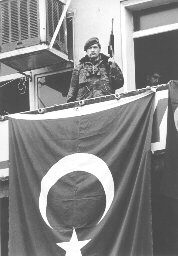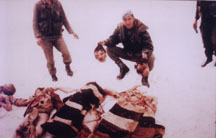Site Index
Wars A brief overview of political violence in Turkey and Kurdistan.
Personalities Some information on powerful (or interesting) people in the region.
TravelAn alternative Guide to Turkey.
Media Links On-line media about Turkey and KurdistanLinks to political sites about Turkey and Kurdistan.
Political Links Links to political sites about Turkey and Kurdistan.
Peoples & CreedsSome information about the ethnic groups in Turkey, where they live, their languages and their religious practices.
The Wars
 Turkey and Kurdistan have not been blessed with peace in recent years. The
political tensions and frustration of various groups over their
disenfranchisement as well as mere thuggery on the part of security forces has
created a number of wars both big and small in ther region. While all these
wars have connections and common elements, it is best to deal with them
separately.
Turkey and Kurdistan have not been blessed with peace in recent years. The
political tensions and frustration of various groups over their
disenfranchisement as well as mere thuggery on the part of security forces has
created a number of wars both big and small in ther region. While all these
wars have connections and common elements, it is best to deal with them
separately.
War in Turkey
 Turkish security forces have been fighting with various Marxist guerilla
organisations for almost thirty years. For the most part, these guerilla
groups are miniscule fractions, but larger organisations like the DHKP-C can
probably field close to a thousand fighters. The DHKP-C's area of operation is
mostly in Istanbul or in the Dersim/Sivas/Tokat region in Central Anatolia.
However, these groups primary strategic focus is on agitprop rather than actual
combat. Turkish Leftist groups have fared poorly in recent years with a good
number of their militants (not guerillas) either imprisoned, murdered or driven
underground.
Turkish security forces have been fighting with various Marxist guerilla
organisations for almost thirty years. For the most part, these guerilla
groups are miniscule fractions, but larger organisations like the DHKP-C can
probably field close to a thousand fighters. The DHKP-C's area of operation is
mostly in Istanbul or in the Dersim/Sivas/Tokat region in Central Anatolia.
However, these groups primary strategic focus is on agitprop rather than actual
combat. Turkish Leftist groups have fared poorly in recent years with a good
number of their militants (not guerillas) either imprisoned, murdered or driven
underground.
The more serious war is the war between the PKK and security forces in the southeast provinces of the country. The war is said to have begun in 1984, but really the war against Kurds has continued more or less continuously since 1925. It is only in recent years that Kurdish groups have become more organised and thus more effecively. The war greatly intensified around the Kurdish new year, Newroz, 21 March 1992 when the army attacked marchers in Sirnak. Fighting escalated rapidly in the region and near conventional battles were fought. Conservative estimates put the total number of casualties on both sides at arounf 30,000 since 1984. However, since 1993 by the Turkish government's own figures some 3,000 villages have been destroyed by security forces and some two million refugees created. This is part of an ongoing program to deny the PKK access to supply as well as to reduce the concentration of Kurds in the southeast by forcing them to resettle elsewhere.
 As brutal as the shooting war has been, the Kurds have been the victims of
genocidal pressure to assimilate culturally to official Turkish standards.
Laws have been passed -- and enforced -- which have forbidden using Kurdish
language for instruction, publishing, musical performances and even in private
conversations in one's home. Even giving children Kurdish names has been
forbidden. In recent years some of the more unenforcible of these provisions
have been relaxed, but in general any expression of Kurdish identity is
forbidden.
As brutal as the shooting war has been, the Kurds have been the victims of
genocidal pressure to assimilate culturally to official Turkish standards.
Laws have been passed -- and enforced -- which have forbidden using Kurdish
language for instruction, publishing, musical performances and even in private
conversations in one's home. Even giving children Kurdish names has been
forbidden. In recent years some of the more unenforcible of these provisions
have been relaxed, but in general any expression of Kurdish identity is
forbidden.
A recent development may have caused irreparable damage to the PKK. In October 1998 the Turkish army massed units on the Syrian frontier and threatened military action against Syria unless they ceased all aid to the PKK and either turned over or expelled Apo. After a two-week stand off, Syria knuckled under and expelled Apo who is now in Russia applying for political asylum. In November the Duma voted unanimously to grant asylum. Several hundred PKK fighers have also been expelled from Syria to Northern Iraq.
Iraq's War
As bloody as Turkey's war with its Kurdish population has been, the amount of bloodshed in Iraqi Kurdistan is far more horrifying. While Iraqi Kurds enjoy far more cultural rights than their cousins in Turkey, they have been far more brutalized in recent years. Saddam Hussayn carried out a series of operations against KDP and PUK fighting units in the late 1980s known as Anfal in which an estimated 200,000 Kurds were killed in organised massacres reminiscent of Nazi Germany and by the bombing of Kurdish towns and villages with chemical weapons.
At the end of the War with the United States over Kuwait, the Kurds rose once again and when Saddam Hussayn no longer had to worry about the allied forces, he sent his armour and helicopters into Kurdistan once again. One and a half million Kurds fled in panic for Turkey and Iran. The result of this (after a considerable amount of very bad press) was Operation Provide Comfort, a NATO operation flying out of Incirlik Air Force base in Turkey to keep the Iraqi army out of Northern Iraq.
This did not let the Kurds off the hook for violent death. Shortly after the formation of the Kurdish Autonomous Region, the two main factions of the KDP and the PUK began fighting each other. To add to the misery of the local inhabitants, Turkey began massive combined air-ground operations in the area to root out PKK guerillas, operations which resulted in thousands of Iraqi Kurdish casualties. These operations are still continuing.